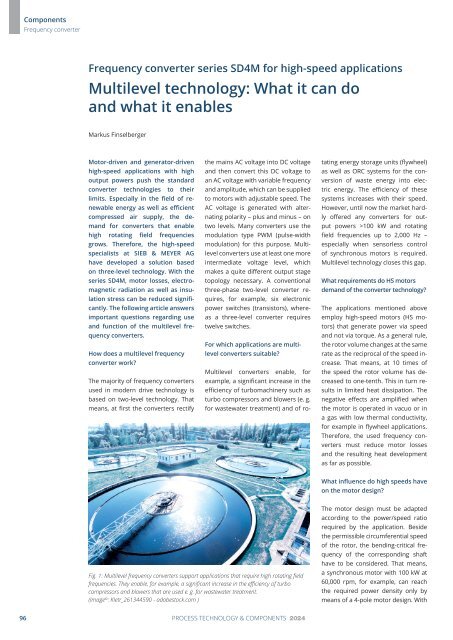PuK - Process Technology & Components 2024
A technical trade magazine with a history of more than 60 years.
A technical trade magazine with a history of more than 60 years.
You also want an ePaper? Increase the reach of your titles
YUMPU automatically turns print PDFs into web optimized ePapers that Google loves.
<strong>Components</strong><br />
Frequency converter<br />
Frequency converter series SD4M for high-speed applications<br />
Multilevel technology: What it can do<br />
and what it enables<br />
Markus Finselberger<br />
Motor-driven and generator-driven<br />
high-speed applications with high<br />
output powers push the standard<br />
converter technologies to their<br />
limits. Especially in the field of renewable<br />
energy as well as efficient<br />
compressed air supply, the demand<br />
for converters that enable<br />
high rotating field frequencies<br />
grows. Therefore, the high-speed<br />
specialists at SIEB & MEYER AG<br />
have developed a solution based<br />
on three-level technology. With the<br />
series SD4M, motor losses, electromagnetic<br />
radiation as well as insulation<br />
stress can be reduced significantly.<br />
The following article answers<br />
important questions regarding use<br />
and function of the multilevel frequency<br />
converters.<br />
How does a multilevel frequency<br />
converter work?<br />
The majority of frequency converters<br />
used in modern drive technology is<br />
based on two-level technology. That<br />
means, at first the converters rectify<br />
the mains AC voltage into DC voltage<br />
and then convert this DC voltage to<br />
an AC voltage with variable frequency<br />
and amplitude, which can be supplied<br />
to motors with adjustable speed. The<br />
AC voltage is generated with alternating<br />
polarity – plus and minus – on<br />
two levels. Many converters use the<br />
modulation type PWM (pulse-width<br />
modulation) for this purpose. Multilevel<br />
converters use at least one more<br />
intermediate voltage level, which<br />
makes a quite different output stage<br />
topology neces sary. A conventional<br />
three-phase two-level converter requires,<br />
for example, six electronic<br />
power switches (transistors), whereas<br />
a three-level converter requires<br />
twelve switches.<br />
For which applications are multilevel<br />
converters suitable?<br />
Multilevel converters enable, for<br />
example, a significant increase in the<br />
efficiency of turbomachinery such as<br />
turbo compressors and blowers (e. g.<br />
for wastewater treatment) and of rotating<br />
energy storage units (flywheel)<br />
as well as ORC systems for the conversion<br />
of waste energy into electric<br />
energy. The efficiency of these<br />
systems increases with their speed.<br />
However, until now the market hardly<br />
offered any converters for output<br />
powers >100 kW and rotating<br />
field frequencies up to 2,000 Hz –<br />
especially when sensorless control<br />
of synchronous motors is required.<br />
Multi level technology closes this gap.<br />
What requirements do HS motors<br />
demand of the converter technology?<br />
The applications mentioned above<br />
employ high-speed motors (HS motors)<br />
that generate power via speed<br />
and not via torque. As a general rule,<br />
the rotor volume changes at the same<br />
rate as the reciprocal of the speed increase.<br />
That means, at 10 times of<br />
the speed the rotor volume has decreased<br />
to one-tenth. This in turn results<br />
in limited heat dissipation. The<br />
negative effects are amplified when<br />
the motor is operated in vacuo or in<br />
a gas with low thermal conductivity,<br />
for example in flywheel applications.<br />
Therefore, the used frequency converters<br />
must reduce motor losses<br />
and the resulting heat development<br />
as far as possible.<br />
What influence do high speeds have<br />
on the motor design?<br />
Fig. 1: Multilevel frequency converters support applications that require high rotating field<br />
frequencies. They enable, for example, a significant increase in the efficiency of turbo<br />
compressors and blowers that are used e. g. for wastewater treatment.<br />
(Image © : Kletr_261344590 - adobestock.com )<br />
The motor design must be adapted<br />
according to the power/speed ratio<br />
required by the application. Beside<br />
the permissible circumferential speed<br />
of the rotor, the bending-critical frequency<br />
of the corresponding shaft<br />
have to be considered. That means,<br />
a synchronous motor with 100 kW at<br />
60,000 rpm, for example, can reach<br />
the required power density only by<br />
means of a 4-pole motor design. With<br />
96 PROCESS TECHNOLOGY & COMPONENTS <strong>2024</strong>

















